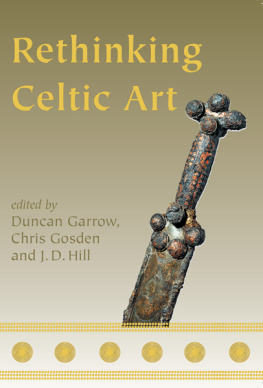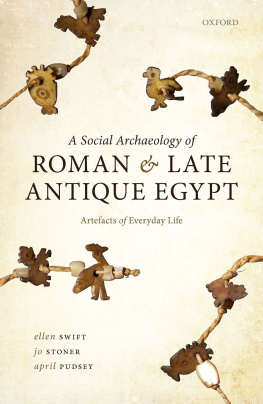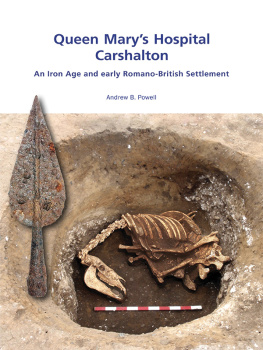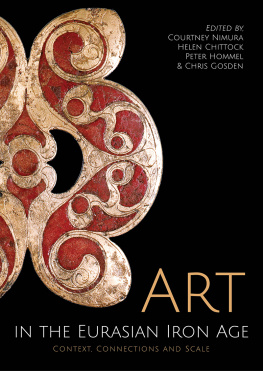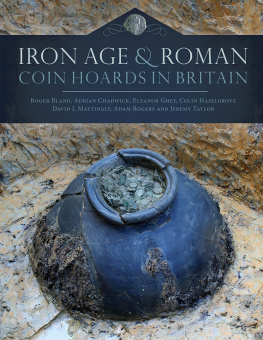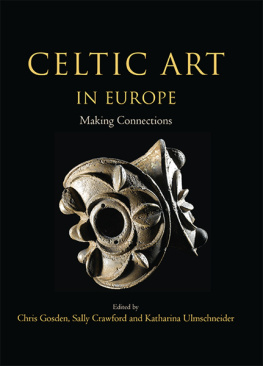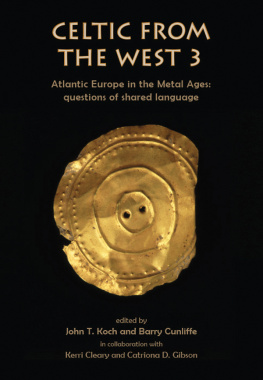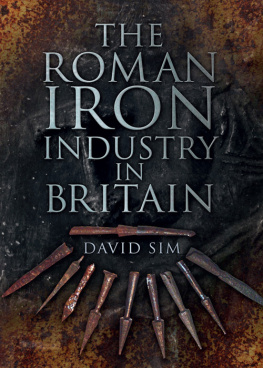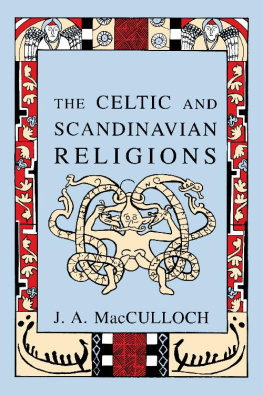Published in the United Kingdom by
OXBOW BOOKS
10 Hythe Bridge Street, Oxford OX1 2EW
and in the United States by
OXBOW BOOKS
908 Darby Road, Havertown, PA 19083
Oxbow Books and the individual contributors 2008
Paperback Edition: ISBN 978-1-84217-318-3
E-pub Edition: ISBN 978-1-78297-821-3; Mobi: ISBN 978-1-78297-822-0;
PDF: ISBN 978-1-78297-823-7
First printed 2008
Reprinted 2014
A CIP record for this book is available from the British Library
For a complete list of Oxbow titles, please contact:
UNITED KINGDOM
Oxbow Books
Telephone (01865) 241249, Fax (01865) 794449
Email:
www.oxbowbooks.com
UNITED STATES OF AMERICA
Oxbow Books
Telephone (800) 791-9354, Fax (610) 853-9146
Email:
www.casemateacademic.com/oxbow
Oxbow Books is part of the Casemate Group
Cover: The upper part of the Kirkburn sword. Copyright the Trustees of The British Museum
Contents
(Chris Gosden and J. D. Hill)
(Duncan Garrow)
(Vincent and Ruth Megaw)
(Melanie Giles)
(Jody Joy)
(Ian Leins)
(Hella Eckardt)
(Fraser Hunter)
(Mary Davis and Adam Gwilt)
(Mansel Spratling)
(Niall Sharples)
(David Mattingly)
List of Contributors
MARY DAVIS Department of Archaeology & Numismatics, Amgueddfa Cymru National Museum Wales, Cathays Park, Cardiff CF10 3NP
HELLA ECKARDT Archaeology, School of Human and Environmental Sciences, University of Reading, Whiteknights, PO Box 227, Reading RG6 6AB
DUNCAN GARROW School of Archaeology, Classics and Egyptology, University of Liverpool, Hartley Building, Brownlow Street, Liverpool L69 3GS
MELANIE GILES Archaeology, University of Manchester, Mansfield Cooper Building, Oxford Road, Manchester M13 9PL
CHRIS GOSDEN Institute of Archaeology, University of Oxford, 36 Beaumont Street, Oxford OX1 2PG
ADAM GWILT Department of Archaeology & Numismatics, Amgueddfa Cymru National Museum Wales, Cathays Park, Cardiff CF10 3NP
J. D. HILL The British Museum, Great Russell Street, London WC1B 3DG
FRASER HUNTER National Museum of Scotland, Chambers Street, Edinburgh EH1 1JF
JODY JOY Department of Prehistory and Europe, The British Museum, Great Russell Street, London WC1B 3DG
IAN LEINS Department of Coins and Medals, The British Museum, Great Russell Street, London WC1B 3DG
DAVID MATTINGLY School of Archaeology and Ancient History, University of Leicester, University Road, Leicester LE1 7RH
VINCENT AND RUTH MEGAW Department of Archaeology, Room 215, Humanities Building, School of Humanities, Flinders University, GPO Box 2100, Adelaide SA 5001, Australia
or
Department of Archaeology, University of Glasgow, The Gregory Building, Lilybank Gardens, Glasgow G12 8QQ
NIALL SHARPLES School of History and Archaeology, Cardiff University, Humanities Building, Colum Drive, Cardiff CF10 3EU
MANSEL SPRATLING 73 Coolidge Gardens, Cottenham, Cambridge CB24 8RQ
Introduction: re-integrating Celtic art
Chris Gosden and J. D. Hill
The material known as Early Celtic art represents an odd collective of objects which owes as much to archaeologists categories as it does to any mode of grouping or using the material in the Iron Age. Generally included under this label are personal ornaments (such as arm rings and torcs), weapons or armour (daggers, helmets, shields and swords), horse and chariot gear and varied items including fire dogs, mirrors, spoons and tankards (see Garrow this volume for more details). Brooches and coins are generally excluded, except on those occasions where details of form or iconography make it relevant to draw them into a discussion. These items are first found in Britain around 350 BC (although dating is a problem) and they continue until well after the Roman invasion of AD 43. A variety of decoration is seen ranging from human or animal forms (abstract or realistic), curvilinear designs in engraved or three-dimensional forms, along with geometrical designs, and the use of glass inlays (often wrongly called enamelling) a prominent feature of British material. The majority of objects are made from bronze, brass or iron, but are also found in silver, electrum or gold, or, very rarely pottery, wood and bone. The forms and decoration of the British objects are often linked to continental types and seen by many to have continental origins ultimately (a notion we question below). British Early Celtic art is distinctively different from that found in other parts of Europe, a feature widely recognised by the use of the term insular, and there are very few objects imported into Britain from elsewhere.
A key feature of discussions of British and Irish Early Celtic art has been the separation between considerations of this material and the rest of the evidence from the Iron Age. The lack of graves in Britain for much of the Iron Age means that the majority of the finds counted as Celtic art are from dry land hoards or wet contexts, with a minority from settlements or burials, so that they lack the sorts of contextual details that can link them to other aspects of the archaeological record. Dating is also a problem. Even where burials are found, such as in East Yorkshire, Cornwall or Central East Scotland, they are generally poor in grave goods compared to those in other parts of Europe. This paucity of finds in settlements or graves, together with the lack of Celtic art motifs on pottery or bone, means that the corpus of Celtic art has been cut off from more general considerations of the archaeological evidence, becoming a specialised area of study in its own right. In order to understand how this might change, so that Celtic art becomes reintegrated into broader considerations of archaeology, let us look at past and current discussions of the late Iron Age more generally.
The late Iron Age has always been seen as a period of dynamic change although the reasons adduced for this dynamism have changed over the years. In early considerations it was thought that the movement of people from the continent into southeast England set in train changes of burial rite and social formations more generally, a view starting with Evans (1890) consideration of the Aylesford cemetery based around notions of Belgic immigrants, an idea picked up by Hawkes and Dunning (1931) and refined by Hawkes (1959). Although the idea of migration was firmly dismissed in the 1960s and 1970s with many explanations stressing internally derived change, the importance of continental influence remained through to the 1980s and beyond, with core-periphery models emphasising the importance of links with Gaul which in turn was a conduit for Mediterranean influence. In all these models change is derived from the continent late in the first millennium BC which brought about new developments in southeast English social, economic and political forms, which in turn influenced the rest of Britain (Haselgrove 1982, Cunliffe 1986).
Very recently, the sheer volatility and the unusual nature of the changes in south eastern England in the first centuries BC and AD have been emphasised (Haselgrove and Moore 2007, Hill 2007). Increasing bodies of material from research and rescue excavations across the rest of Britain and Ireland have suggested the changes seen in the late Iron Age in south eastern England after 100 BC are just one manifestation of a broad series of social, cultural and economic changes that took place across Atlantic Europe from the 3rd/2nd centuries BC onwards. A longer temporal perspective on the later Iron Age together with a broader geographical consideration is starting to challenge interpretations that see social and material changes as having external causes. Indeed, it is now less clear what is internal and what external or whether the Channel and the North Sea provided bridges or barriers. A new picture is emerging of dynamic and interconnected agrarian societies, often showing strong concerns to maintain a local identity, but while still taking up cultural forms of widespread currency. This balancing between the global and the local takes place against a pattern of expanding populations, intensification of agriculture and artefactual production, changes in kinship groups and the manner in which objects were used to mark relationships. It is into this fast-changing situation that we have to insert our understanding of Early Celtic art and its subsequent changes over the centuries. Not least we have to be aware of the Roman context, as so much of the material from southern Britain was deposited in the first century AD and the vast majority of the northern corpus is early Roman (i.e. AD 50200).
Next page
